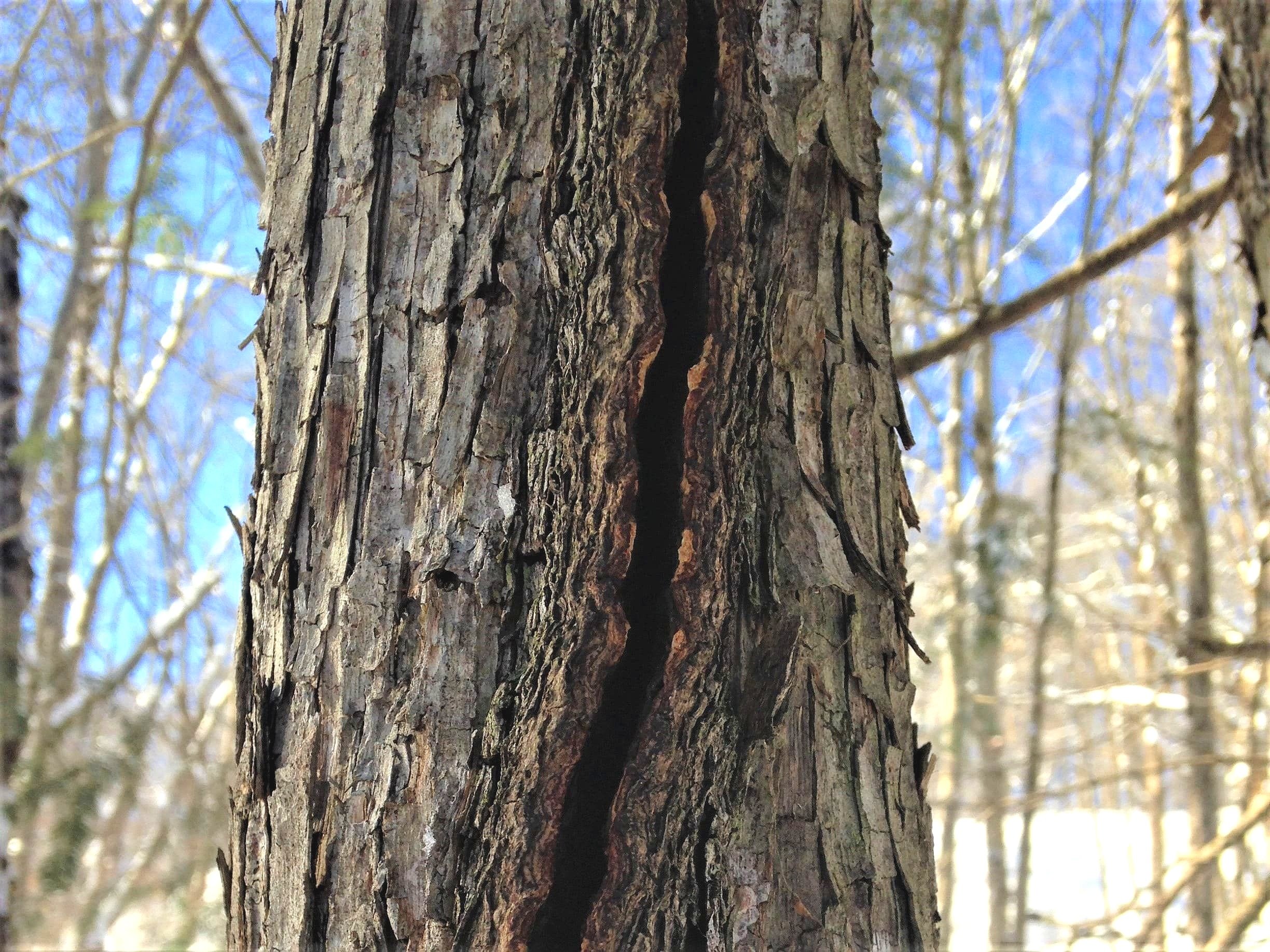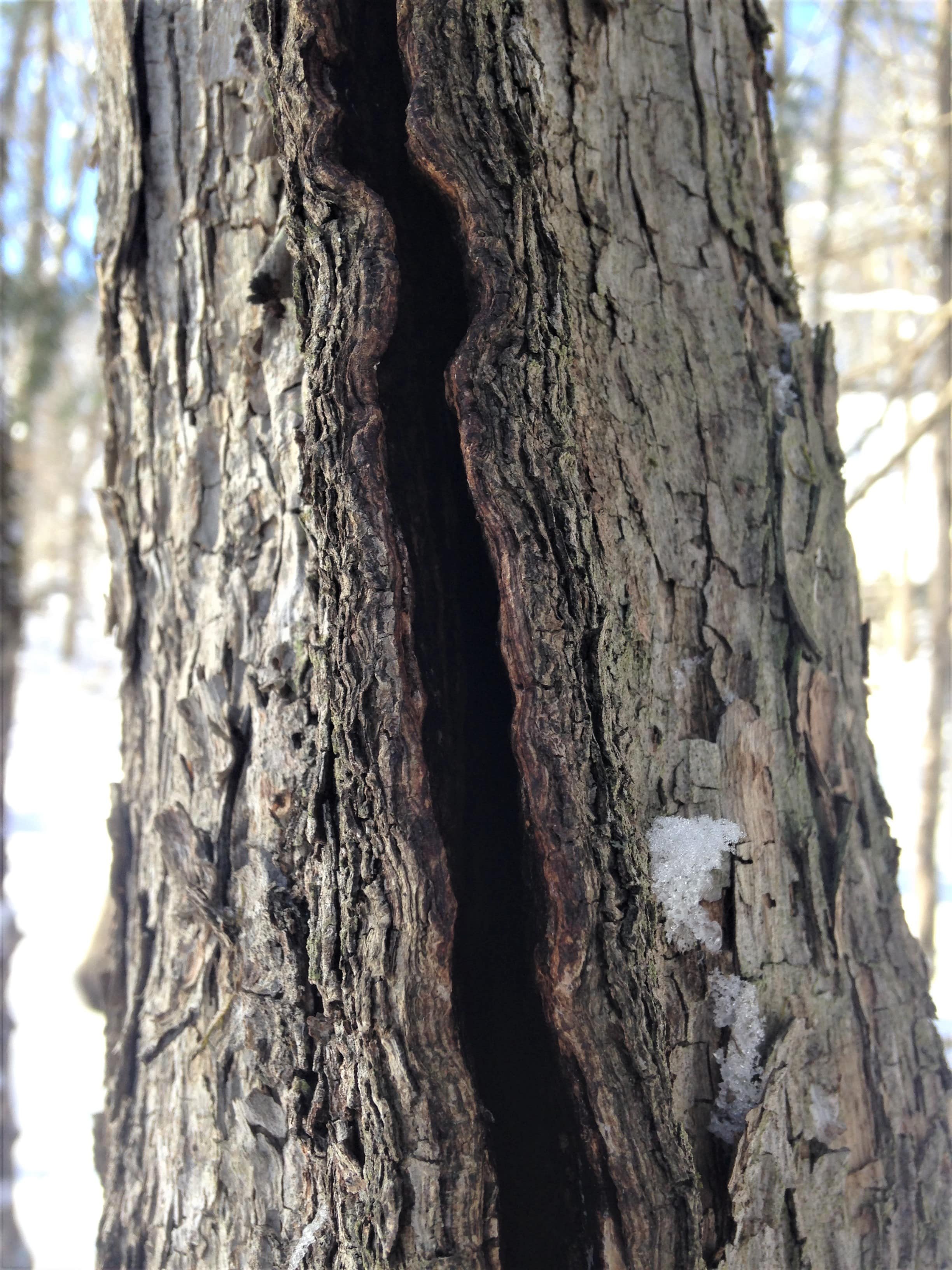Frost Cracking
Frost cracking along American Beech (Fagus grandifolia) tree, Lake of Bays, 2022.02.12
A couple of years ago on a trail which circled Sasajewun Lake at the Algonquin Wildlife Research Station, we came across a few trees that I thought had been struck by lightning. I saw fissures in the tree, some shallow, some deeper. These fissures wrapped in a long loose spiral around the trunk of the tree from fairly high up most of the way down. Many different tree species had these fissures and many were near the path. This is when I started to think again about lightning strikes. How did so many trees along a single path get struck by lightning? Turns out they didn’t. Instead it was pointed out to me, through a number of questions and detailed observations, that the fissures were likely caused by frost cracking.
We saw many trees on our most recent trip to the Algonquin area with the tracking apprenticeship program, and I realized I still didn’t know much about frost cracking so I figured I would look it up.
What causes this cracking?
My favorite days of the year are the bright sunny blue days in the middle of Winter. When the ambient temperature can get to be between -20°C to -30°C (-4°F to -22°F), but the sun is blasting down, it is such a gift. I feel warmed so much by the suns rays that the air temperature doesn’t bother me much. But there is a problem. When trees are warmed by the sun the bark and wood below slowly expand. If the tree has darker bark they heat up more and expand a little faster. Now when the sun goes down, the bark and wood will start to contract. This contracting is faster for the bark than it is for the wood inside the tree. If you can imagine the bark quickly shrinking around a slowly inner wood you can probably imagine the inevitable tear or crack which will appear as the bark becomes too small to hold the expanded inner wood. Cracking usually initates at the site of a previous wound as the scar tissue in the heal is less pliant. Cracking may happen more than once in the same spot, expanding and deepening the fissure, eventually working in towards the center of the tree. This could make the tree more vulnerable to blowdown, damage from snow loads, and totally exposed to pathogens and bacteria which can infest the rest of the tree.
The cracks most often occur on the South or West side of the trees because these sides get the most daytime warming and tend to be warmest at the end of the day (when the East side has usually had time to cool somewhat).
Frost cracking doesn’t usually occur in coniferous trees as they retain their leaves/needles throughout the Winter and thus the bark doesn’t warm up significantly.
Photo by Steffanie Scott, taken 2022.02.13
Why the spiral form?
The loose spiral form the cracking takes has to do with the grain of the wood but then that brings up the question of why does the wood grain spiral? There are many different theories. Some folks have written about the prevailing wind direction in a region, but spiraling can present as left-handed or right-handed or even change direction over the years of a trees life. The prevailing wind direction doesn’t really change. I have also read about spiral grain being induced by slope of the hill which the tree has grown on. The theory goes something like if the hill is facing the South, the tree will continue to turn so that the shaded out branches on the North side get more sun. This causes the tree to continuously spiral as they grow. I have also read a great article by Robert. W. Chambers on spiral grain logs for use in building log homes. At the end of the article he writes:
[A]ll the science I have read agrees: spiral grain is overwhelmingly genetic. The seeds and cones from righthand trees tend to produce righthand young’ns. It is not surprising that most of the trees on a north slope somewhere have about the same spiral grain—they’re closely related…I guess cones don’t fall far from the tree.
What does a lightning strike look like then?
Lightning is pretty amazing. Someday, I’ll write an entry on thunderstorms and how they happen, but for now I’ll try and keep to the context of this blog post.
Lightning can heat the air is passes through to a improbable temperature of about 27,760°C (50,000°F)! That’s insane. The surface of the sun is about 5505°C (9941°F) so lightning can actually heat the air to 5x the temperature than the surface of the sun!! No wonder it can be so destructive. It isn’t always that hot but it certainly does heat things up. As one blog I read wrote “it’s not the voltage that kills the tree, it’s the water.”
When lightning hits a tree a couple of different things can happen depending on the course the lightning takes. If the electricity hits the side and runs through the cambium, then the sap instantly boils, massive amounts of steam is generated and then cells explode in the wood, leading to strips of wood and bark quickly being blown off the tree. If there is a crack in the tree that does not run all the way along the length of the trunk it might be due to a “side flash”. A side flash happens when electricity strikes the tree, travels down the trunk, then jumps to an object with less electrical resistance, like a fence nearby. If the lightning runs through the middle of the trunk, then the whole tree can explode, throwing long thick slivers for many meters. It sounds like there is a wide array of ways that lightning can impact a tree depending on factors like how much water is in the tree, the intensity of the strike, the species of tree and the structure of the individual tree.
To wrap this up I wanted to take another look at a question from the Kamana Naturalist Training Course “Tourist Test”. The Tourist Test was written to get folks to consider how much they actually know about the natural history in the area where they live. Question 7 asks “What type of tree is lightning most likely to strike in your area?”
My research suggests that it might be Eastern White Pine (Pinus strobus), Bur Oaks (Quercus macrocarpa) or Willows (Salix spp.) due to the height of the trees and the corrugated bark which can hold a lot of moisture content. I’ll have to look into it a little more though.
To learn more :
Spiral Grain—The Inside Story
The Middlebury Landscape blog post “Lightning 1, Spruce 0”




